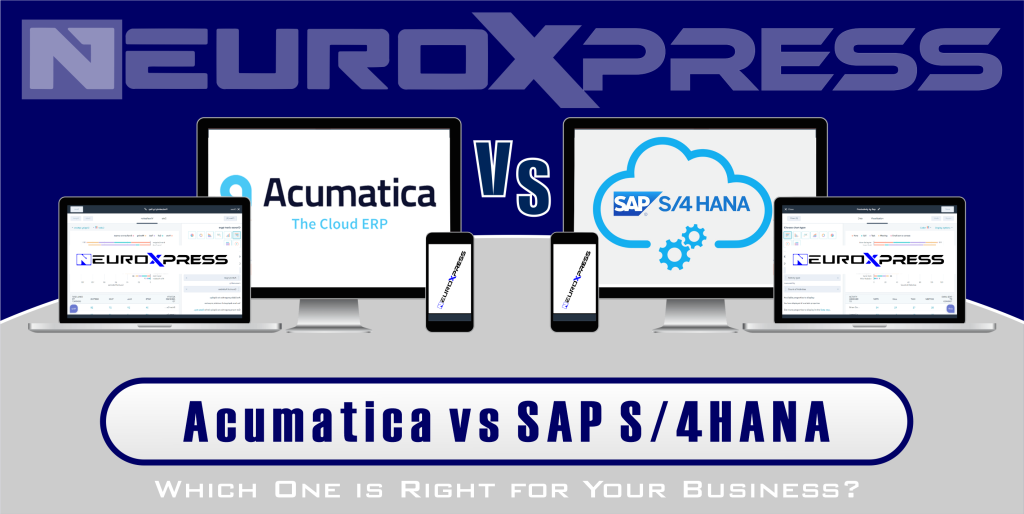Acumatica Cloud ERP vs SAP S/4HANA: Choosing the Right ERP for Your Business

Introduction: The ERP Crossroad
In the bustling heart of a fast-growing manufacturing company in Chicago, Jason—the CTO—faced a dilemma that many business leaders encounter today. His team was drowning in disconnected data, slow reporting, and an inflexible legacy ERP system. The company needed a scalable, cloud-based solution that could keep pace with their growth. After weeks of research, he narrowed down the choice to two titans in the ERP world: Acumatica Cloud ERP vs SAP S/4HANA.
This story isn’t unique. Across industries, companies are asking the same question: Which ERP platform is the right one for us? If you’re stuck at the same crossroads, this in-depth, objective ERP Software comparison of Acumatica Cloud ERP vs SAP S/4HANA will give you the clarity you need.
What is Acumatica Cloud ERP?
Acumatica is a modern, cloud-native ERP solution designed primarily for small to mid-sized businesses. Known for its open architecture, user-friendly interface, and pricing transparency, it supports a variety of industries including manufacturing, distribution, retail, construction, and services.
Key Highlights:
- 100% cloud-based with on-premise option
- Flexible pricing based on usage, not per-user
- Strong focus on usability and integration
What is SAP S/4HANA?
SAP S/4HANA is the next-generation ERP suite from SAP, tailored for large enterprises and complex business processes. It leverages in-memory computing for real-time analytics and transactions.
Key Highlights:
- Built on SAP HANA, a high-performance in-memory platform
- Comprehensive features for global enterprise needs
- Deep industry-specific modules
Acumatica Cloud ERP vs SAP S/4HANA: Feature Comparison Table
| Feature | Acumatica Cloud ERP | SAP S/4HANA |
|---|---|---|
| Deployment | Cloud, On-premise, Hybrid | Cloud, On-premise, Hybrid |
| Pricing Model | Resource-based | User-based |
| Industry Focus | SMBs: Manufacturing, Construction | Large Enterprises: All Industries |
| User Interface | Modern, user-friendly | Powerful but complex |
| Customization & Extensibility | High | Very High |
| Integration | Open APIs, REST, Web Services | SAP ecosystem, BAPI, OData, API Hub |
| Analytics & Reporting | Embedded dashboards, Power BI | Real-time analytics via HANA |
| Mobile Access | Native mobile support | SAP Fiori apps |
| AI/ML Capabilities | Emerging via ISVs | Built-in intelligent technologies |
| Partner Ecosystem | Growing | Massive global ecosystem |
Storytelling: When Speed Meets Complexity
In 2023, a mid-size eCommerce company on the West Coast needed to upgrade from QuickBooks to a real ERP. They needed something fast to deploy, affordable, but still powerful. After choosing Acumatica, their operations became 40% more efficient in just 6 months.
Meanwhile, an international pharmaceutical company had complex compliance and logistics needs. SAP S/4HANA was the natural fit. Though the implementation took over a year, the results were phenomenal: end-to-end automation, global visibility, and real-time control.
These two stories show what kind of business each ERP truly serves.
Pros and Cons Comparison Table
| Criteria | Acumatica Cloud ERP | SAP S/4HANA |
|---|---|---|
| ✅ Pros | ||
| Affordable for SMBs | Built for complex, global operations | |
| Flexible licensing model | Deep industry-specific capabilities | |
| Fast deployment | Powerful analytics with HANA | |
| Strong integration support | Huge partner ecosystem | |
| Easy to use & modern UI | Scalable to thousands of users | |
| ❌ Cons | ||
| Limited native AI features | Expensive licensing & implementation | |
| Smaller partner ecosystem | Longer deployment timeline | |
| Not ideal for very large enterprises | Steeper learning curve |
Ideal Use Cases
Acumatica Cloud ERP is best for:
- SMBs with rapid growth
- Businesses with limited IT infrastructure
- Companies looking for fast ROI
- Organizations seeking transparent pricing
SAP S/4HANA is best for:
- Multinational corporations
- Regulated industries (e.g., pharma, finance)
- Companies with legacy SAP systems
- Enterprises requiring deep customization
Pricing & Licensing Model
- Acumatica: Pricing is based on resources used, not per user. This can significantly reduce costs for growing teams.
- SAP S/4HANA: Pricing depends on the number of users, modules, and deployment type. Expect high licensing and consulting fees.
Implementation & Support
- Acumatica: Typically faster (3–6 months), strong VAR network, easier to train staff.
- SAP S/4HANA: Longer (12–24 months), robust global support, complex training programs.
Integration & Extensibility
Both platforms offer strong integration capabilities, but SAP has the edge in supporting legacy systems and global ERPs.
Summary Diagram Table
| Category | Winner |
|---|---|
| Affordability | Acumatica |
| Deployment Flexibility | Tie |
| User Experience | Acumatica |
| Enterprise Capabilities | SAP S/4HANA |
| AI/ML | SAP S/4HANA |
| Analytics | SAP S/4HANA |
| Customization | Tie |
| Speed of Implementation | Acumatica |
| Ecosystem & Support | SAP S/4HANA |
Final Thoughts: Acumatica Cloud ERP vs SAP S/4HANA, Which ERP Should You Choose?
If you’re a small or mid-sized business looking for a flexible, cost-effective ERP that can be deployed quickly, Acumatica Cloud ERP is an excellent choice.
However, if you’re a large enterprise dealing with complex global operations, heavy compliance, and massive data workloads, SAP S/4HANA provides the depth and power you need—at a cost.
The final decision lies in understanding your business’s size, complexity, budget, and growth path.
External Resources & Recommendations